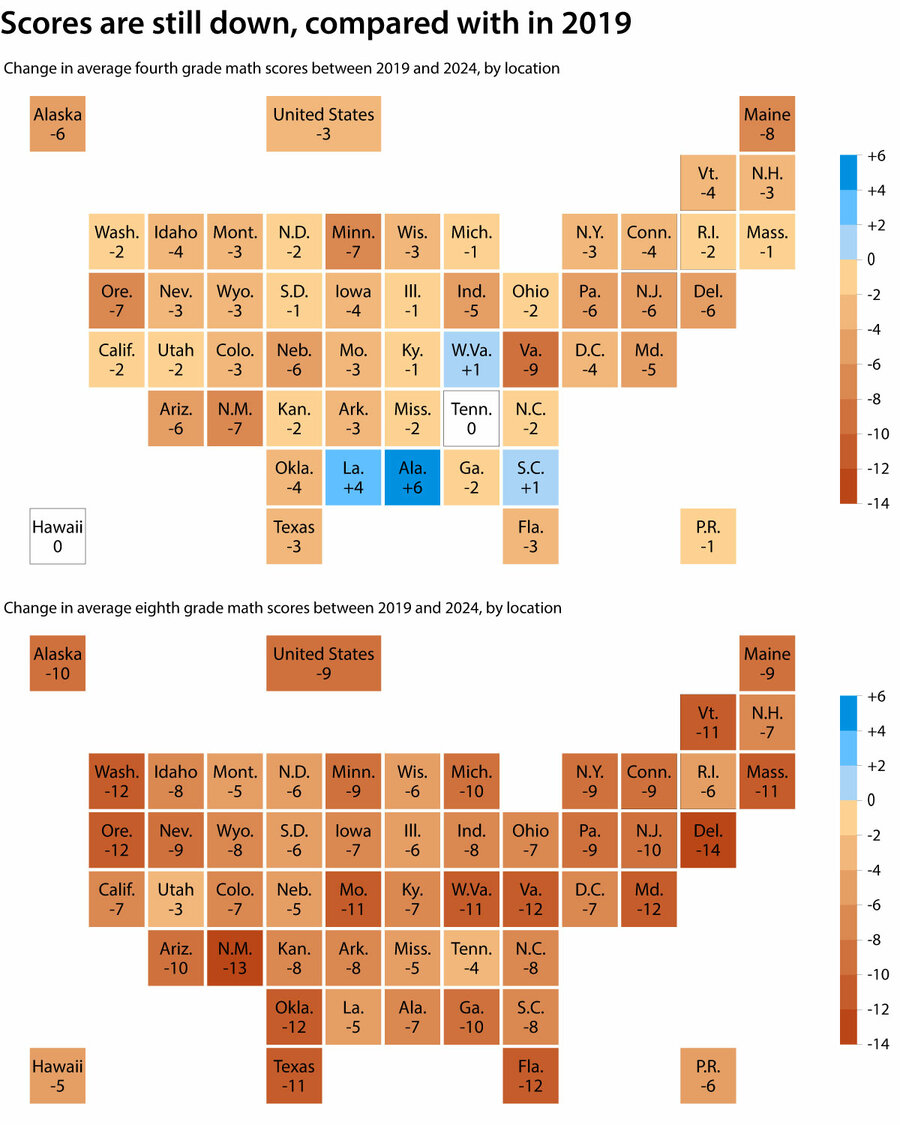America’s struggling college students have fallen additional behind in math and studying.
The newest outcomes from the Nationwide Evaluation of Academic Progress (NAEP), referred to as the “nation’s report card,” underscore the steep challenges that stay practically 5 years after the pandemic disrupted studying for a era of youngsters. By and enormous, the outcomes launched Wednesday paint a grim portrait of educational restoration for the reason that pandemic, particularly in studying.
The lackluster outcomes are additionally sparking questions on what else could also be hindering college students from reaching their full educational potential. Power absenteeism, for instance, continues to be an issue regardless of some enhancements.
Why We Wrote This
Each two years, America’s schoolchildren get a report card on math and studying. The newest outcomes present college students falling additional behind. However officers say it might’t all be blamed on the pandemic.
“The information just isn’t good,” stated Peggy Carr, commissioner of the Nationwide Middle for Training Statistics, which administers the evaluation. “College students who don’t come to highschool usually are not enhancing,” she added throughout a press convention Tuesday.
Each two years, a consultant sampling of fourth graders and eighth graders in the US takes the NAEP examination, which provides a snapshot of scholars’ math and studying progress. The brand new knowledge stems from assessments taken throughout the first quarter of 2024.
The common studying scores for fourth- and eighth-grade college students fell by 2 factors since 2022, persevering with a decline that began earlier than the pandemic. The bottom-performing college students, particularly, wrestle to understand studying. College students within the tenth and twenty fifth percentiles are studying under ranges recorded by college students three a long time in the past.
Plus, a notably giant share of scholars – 40% of fourth graders and 33% of eighth graders – is studying under the take a look at’s fundamental stage. That share of eighth graders is the biggest recorded within the evaluation’s historical past. Proficiency on the nationwide examination means college students have demonstrated competency over difficult material, often with a rigor that exceeds what most states contemplate grade-level achievement. A rating within the fundamental stage on NAEP alerts partial mastery of basic abilities or information.
If the NAEP report comprises any brilliant spots, it’s inside arithmetic. Fourth graders’ common math scores elevated by 2 factors since 2022. Fourteen faculty districts in giant cities resembling Los Angeles, New York, Atlanta, and Washington additionally noticed fourth graders’ common math scores enhance.
Outcomes additionally stood out in Louisiana and Alabama, the place fourth grade studying and fourth grade math confirmed statistically important will increase, respectively.
Raymond Hart, govt director of the Council of the Nice Metropolis Colleges, factors to these features as proof of progress that districts could make, significantly with focused funding.
“Sustaining our federal, state, and native investments [is] essential to make sure that we will preserve these evidence-based practices and techniques that we noticed have been profitable over the previous few years,” he says.
The common math rating for eighth graders didn’t considerably change – an end result pushed by a widening achievement hole between lower- and higher-performing college students.
In the meantime, 40% p.c of fourth graders and 28% of eighth graders carried out at a proficient or superior stage on the mathematics assessments. These percentages replicate will increase from 2022.
“We’ve made some progress, and for some states, important progress. Nevertheless it’s clearly going to take time, so I don’t suppose celebrating is what I see in these knowledge,” Dr. Carr says. “Hope is what I see.”



















